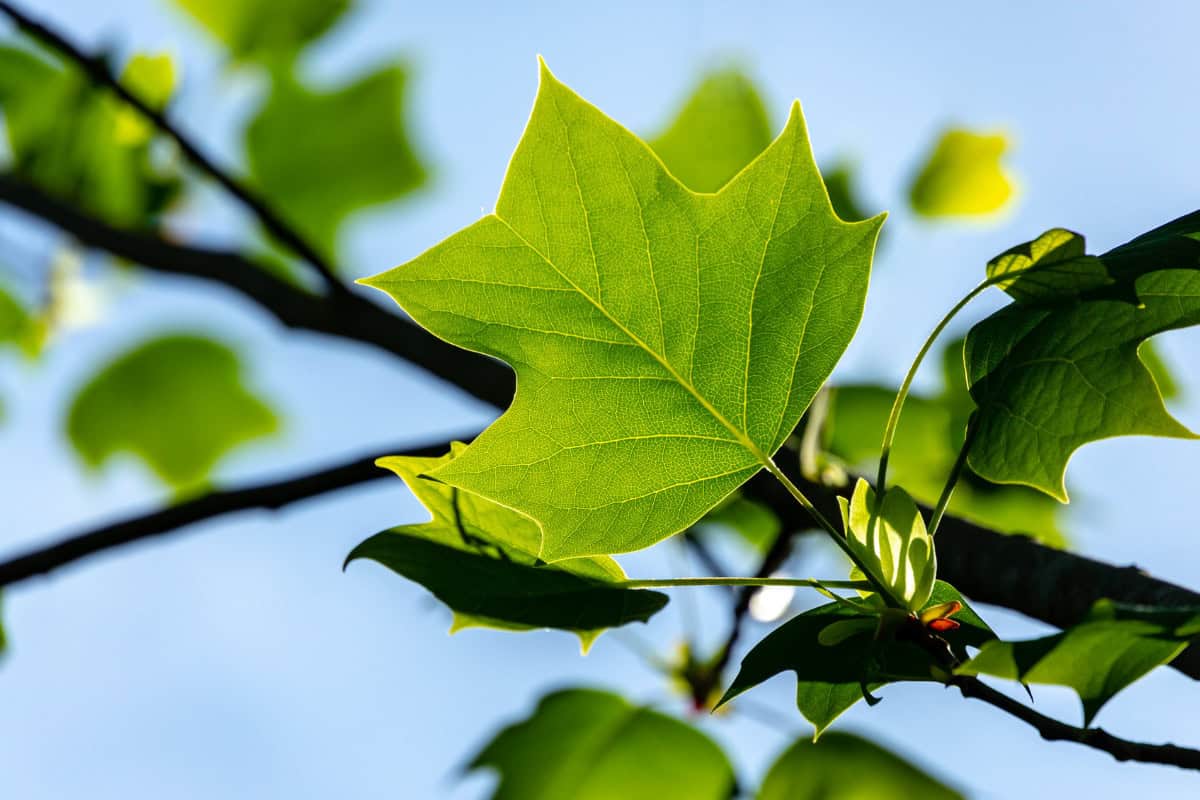
This comprehensive Yellow Poplar firewood profile explores the stately tulip tree of eastern forests, delivering 14,000-17,000 BTUs per cord with excellent splitting characteristics and distinctive greenish-yellow wood properties.
Known for its outstanding processing ease and unique tulip-shaped flowers, Yellow Poplar offers enhanced performance that excels in transitional burning applications while providing clean-burning characteristics ideal for shoulder season heating.
Quick Reference Stats
- Wood Type: Hardwood (deciduous broadleaf)
- BTU Rating: 14,000-17,000 BTUs per cord
- Ease of Splitting: Easy (4/5 scale)
- Seasoning Time: 6-12 months
- Smoke Production: Low
- Spark/Pop Factor: Low
- Scent Profile: Mild – Clean, slightly floral aroma with subtle fragrance
Overview & Identification
Yellow Poplar stands as the premier transitional hardwood of eastern regions, offering enhanced heat output capabilities from one of eastern North America’s tallest native hardwoods.
This moderately lightweight hardwood provides excellent splitting performance with clean burning characteristics that make it ideal for shoulder season heating and extended burning applications.
The distinctive tulip-shaped leaves and orange-yellow tulip-like flowers make identification straightforward for this magnificent forest giant.
Common Names: Yellow Poplar, Tulip Tree, Tulip Poplar, Whitewood
Scientific Name: Liriodendron tulipifera (family Magnoliaceae)
Tree Characteristics: Large tree reaching 80-150 feet with distinctive tulip-shaped leaves and orange-yellow tulip-like flowers, featuring straight trunk and distinctive greenish-yellow sapwood.
Geographic Distribution
Where You’ll Find It: Eastern United States from southern New England to northern Florida, west to Illinois and Arkansas
Availability: Good availability throughout range from logging operations, land development, and forest management
Growing Conditions: Prefers deep, moist, well-drained soils and partial shade when young. Thrives in rich bottomlands and protected slopes.
Burning Characteristics
Heat Output & Performance
- BTU Content: Moderate performance suitable for shoulder season heating and transitional applications
- Burn Duration: Burns at moderate rate with decent duration for lighter hardwood
- Coaling Properties: Forms fair coals that provide reasonable heat retention
- Flame Characteristics: Produces clean, steady flames with consistent heat delivery
Ignition & Fire Management
- Ease of Lighting: Good ignition properties – lights reliably and sustains well
- Best Fire Stage: Excellent for transitional burning and shoulder season heating
- Burn Rate: Moderate burning provides sustained heat with reasonable duration
- Heat Consistency: Delivers consistent heat output with steady flame characteristics
Sensory Experience
Smoke Profile
- Smoke Volume: Low smoke production with very clean burning characteristics
- Smoke Color: Light, clean smoke with excellent dispersal
- Smoke Flavor: Mild, neutral flavor suitable for general cooking applications
- Creosote Production: Very low due to clean burning properties and low resin content
Sound & Visual
- Crackling/Popping: Gentle crackling with minimal popping and very low sparking
- Sparking Tendency: Very low spark production due to clean burning characteristics
- Flame Appearance: Clean, steady flames with good visual appeal and consistency
Aroma
- Burning Scent: Mild, clean aroma with subtle floral notes and pleasant fragrance
- Pleasant Factor: Pleasant scent profile that provides subtle background aroma
- Intensity: Moderate aromatic presence that enhances fire experience without dominating
Processing & Preparation
Splitting Characteristics
- Ease of Splitting: Easy splitting due to moderate density and straight grain
- Grain Pattern: Very straight grain with fine, even texture that splits cleanly
- Tools Needed: Standard splitting axe works well for consistent results
- Best Splitting Conditions: Splits best when properly seasoned with good technique
Seasoning Requirements
- Drying Time: 6-12 months for optimal burning due to moderate density and fine grain
- Moisture Content: Reaches target moisture content steadily due to straight grain structure
- Seasoning Tips: Seasons well but benefits from proper stacking and air circulation
- Storage Considerations: Good storage characteristics with moderate decay resistance
Processing Notes
- Chainsaw Considerations: Cuts easily producing clean, fine sawdust with pleasant aroma
- Bark Characteristics: Smooth gray bark becoming furrowed with age
- Handling: Moderate weight makes handling manageable for most users
- Processing Experience: Pleasant processing experience with distinctive greenish wood
Specialized Uses
Shoulder Season Heating
- Transitional Heating: Perfect for spring and fall heating applications
- Mixed Burning: Excellent for mixing with higher BTU hardwoods
- Extended Burning: Good for longer burning sessions with steady heat
- Indoor Applications: Clean burning makes it suitable for indoor heating
Pros & Cons
Advantages
- Good heat output suitable for shoulder season heating applications
- Easy splitting with manageable processing requirements
- Clean burning characteristics with minimal smoke production
- Very low spark production provides excellent fire safety
- Pleasant floral aroma enhances fire experience
- Good availability throughout eastern regions
- Moderate seasoning time with predictable drying
- Straight grain provides consistent splitting performance
- Suitable for both heating and recreational applications
- Distinctive greenish wood provides unique character
Disadvantages
- Moderate BTU output insufficient for primary winter heating
- Burns faster than premium hardwoods requiring more frequent loading
- Limited coaling ability compared to dense hardwoods
- Not suitable for high-heat or extended heating applications
- Moderate seasoning time compared to faster-drying woods
- Lower density provides less heat value per volume
- May require mixing with higher BTU woods for winter heating
- Limited specialty applications or distinctive characteristics
- Greenish wood color may be unappealing to some users
- Falls short of premium hardwood performance standards
Best Practices & Tips
Shoulder Season Strategy
- Perfect for spring and fall when moderate heat is needed
- Excellent for transitioning between winter and summer fire needs
- Use for recreational fires when heating is secondary concern
- Combine with premium hardwoods for extended winter heating
Mixed Burning Applications
- Blend with oak or hickory for enhanced heat output
- Use as transition wood between kindling and premium hardwoods
- Perfect for extending premium hardwood supplies
- Excellent for recreational fires with moderate heat needs
Processing Optimization
- Split along straight grain for optimal results
- Season properly for best burning characteristics
- Store in well-ventilated areas for efficient drying
- Process into consistent sizes for uniform burning
Bottom Line
Yellow Poplar represents solid transitional hardwood performance, offering good heat output combined with easy processing that makes it valuable for shoulder season heating and recreational applications.
While insufficient for primary winter heating due to moderate BTU output, its clean burning characteristics and pleasant processing make it excellent for users seeking reliable moderate-heat wood with easy handling.
Best For: Shoulder season heating, transitional burning, recreational fires, mixing with premium hardwoods, and moderate heating needs
Skip If: You need primary winter heating, want premium BTU output, require extended coaling, or prefer specialty wood characteristics
🌳 Yellow Poplar Quick Reference Table 🔥
Yellow Poplar is the dependable workhorse that just makes sense for so many situations! This versatile eastern hardwood delivers a solid 14,000-17,000 BTUs per cord while offering that sweet spot between performance and affordability. With pleasant subtle floral notes, manageable processing, and reliable shoulder season heating capabilities, Yellow Poplar represents that practical choice for folks who want genuine heating value without breaking the bank or their back splitting premium hardwoods. 🌻✨
| Characteristic | Rating/Value | Notes |
|---|---|---|
| 🔥 BTU per Cord | 14,000-17,000 | Moderate heating value |
| ⚖️ Density | Moderate-Low | Lightweight hardwood |
| ⏰ Seasoning Time | 6-12 months | Moderate drying time |
| 🪓 Splitting Difficulty | Easy (4/5) ⭐ | Manageable processing |
| 💨 Smoke Production | Low | Clean burning |
| ✨ Spark/Pop Factor | Low 🛡️ | Good safety |
| 🚀 Ignition Ease | Good 🎯 | Reliable lighting |
| ⚡ Burn Rate | Moderate | Reasonable duration |
| 🔥 Coaling Ability | Fair | Some retention |
| 🌸 Scent Quality | Pleasant 🌻 | Subtle floral notes |
| 🍳 Cooking Suitability | Good 👨🍳 | Neutral flavor |
| 🌱 Sustainability | Good 🌿 | Managed forests |
| 📍 Regional Availability | Eastern US | Good distribution |
| 💰 Cost Level | Budget-Moderate 💰 | Transitional pricing |
| 🎯 Best Use | Shoulder season heating | Moderate applications |
| 🏆 Overall Rating | ⭐⭐⭐⭐ | Solid transitional choice |
Related Resources: Yellow Poplar Firewood Profile
Last updated: 7/28/2025


